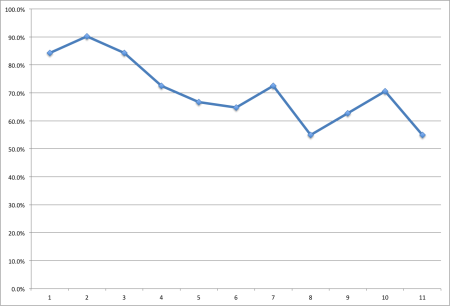Having finally finished grading the second set of late essay assignments, I am now calculating the participation grades for my tutorials in the fall and winter term.
The profile of attendance across time isn’t as flat as one might like, but doesn’t look too dismal:
On Wednesday, I am invigilating the final exam, which we are then meant to mark in a week.
I desperately need to be working on my PhD proposal and research ethics protocol, but I also need to apply for a TA position or some other kind of summer job, just to contain the rate at which my PhD savings are being depleted by food and rent.


After going through a year’s worth of handwritten notes, I am nearly done calculating participation grades.
This shows the breakdown within each tutorial of students enrolled but absent, those present, and those who were present and also participated in the discussion:
The proportion of people absent clearly rises across time, though at least four people dropped the course but are included in the percentages throughout.
The rate of participation is highly variable, which accords with my recollections. For some topics, everyone in the class was eager to express and opinion. For others, I largely found myself reading from my prepared notes for most of the tutorial, unable to foster student engagement.
The topics explain the crater in the active participation rate in the 6th session:
1 – Electoral system
2 – General election outcome
3 – Voting age
4 – Senate reform
5 – Midterm prep
6 – Midterm evaluation
7 – Decentralization
8 – Redistribution
9 – Heath privatization
10 – Language and culture
11 – Final prep
This year, for several reasons, I am not tracking active participation versus attendance. First, doing so uses so much of my attention I do a worse job of leading the discussion overall. Second, it’s impossible not to make errors, especially when people are responding directly to one another and don’t use name cards. Third, it may not be fair to punish people who attend but do not speak.
After my fourth tutorial this week on the 2016 US election, a student who was in an earlier tutorial (same topic, different course, slightly different focus) commented about how tonight’s tutorial featured a much livelier discussion than the earlier one.
It’s a difficult thing to reach credible conclusions about. I don’t think my own conduct varies drastically from tutorial to tutorial, though my voice gets rougher and I incorporate good student comments from earlier tutorials into later ones. They do vary in size and time of day, both of which I expect to be at least somewhat relevant.
Knowing more about it would certainly be valuable, as tutorials are the main chance students get to comment on the material being taught and to engage with one another.